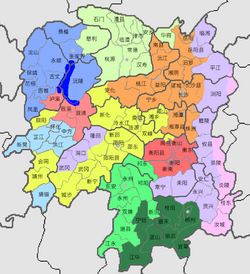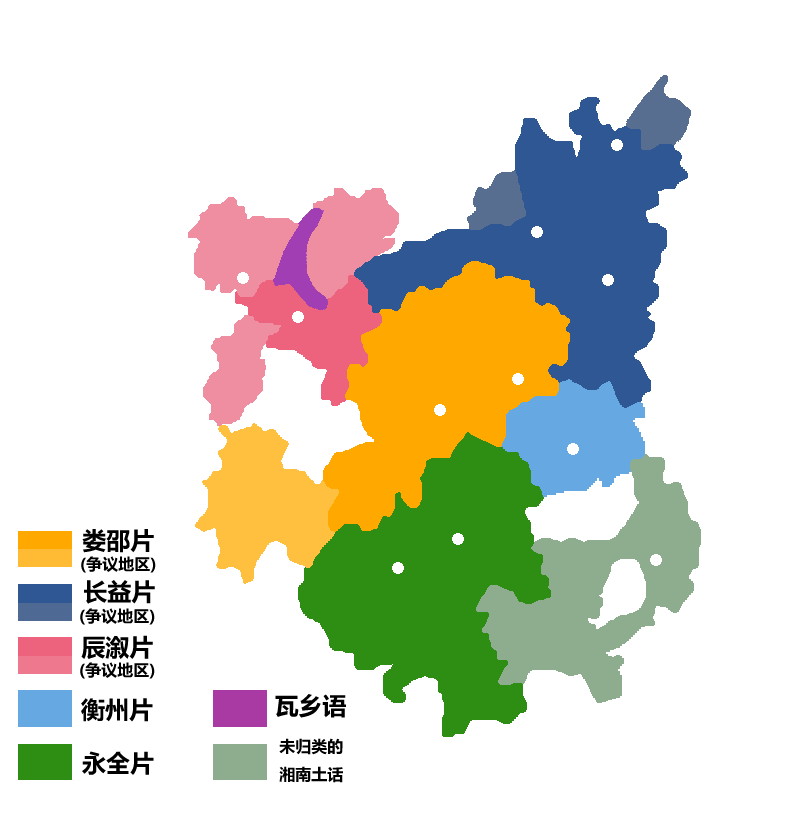Xiang Chinese
Topic: Social
 From HandWiki - Reading time: 9 min
From HandWiki - Reading time: 9 min
| Xiang | |
|---|---|
| Hunanese | |
| 湘語/湘语 | |
 "Xiang Language" written in Chinese characters | |
| Native to | China |
| Region | Central and southwestern Hunan, northern Guangxi, parts of Guizhou, Guangdong, Sichuan, Jiangxi and Hubei provinces |
| Ethnicity | Hunanese people |
Native speakers | 38 million (2021)e26 |
Sino-Tibetan
| |
| Dialects |
|
| Chinese characters | |
| Language codes | |
| ISO 639-3 | hsn |
| Glottolog | xian1251[1] |
| Linguasphere | 79-AAA-e |
Xiang or Hsiang (Chinese: 湘; Changsha Xiang: hsn,[2] Mandarin: cmn), also known as Hunanese, is a group of linguistically similar and historically related Sinitic languages, spoken mainly in Hunan province but also in northern Guangxi and parts of neighboring Guizhou, Guangdong, Sichuan, Jiangxi and Hubei provinces. Scholars divided Xiang into five subgroups, Chang-Yi, Lou-Shao, Hengzhou, Chen-Xu and Yong-Quan.[3] Among those, Lou-shao, also known as Old Xiang, still exhibits the three-way distinction of Middle Chinese obstruents, preserving the voiced stops, fricatives, and affricates. Xiang has also been heavily influenced by Mandarin, which adjoins three of the four sides of the Xiang-speaking territory, and Gan in Jiangxi Province, from where a large population immigrated to Hunan during the Ming dynasty.[4]
Xiang-speaking Hunanese people have played an important role in Modern Chinese history, especially in those reformatory and revolutionary movements such as the Self-Strengthening Movement, Hundred Days' Reform, Xinhai Revolution[5] and Chinese Communist Revolution.[6] Some examples of Xiang speakers are Mao Zedong, Zuo Zongtang, Huang Xing and Ma Ying-jeou.[7]
Historical linguists such as W. South Coblin have been in doubt of a taxonomic grouping of Xiang.[8] However, counterargument suggests that shared innovations can be identified for Xiang.[9][10]
History
Prehistory
Prehistorically, the main inhabitants were the ancient country of Ba, Nanman, Baiyue and other tribes whose languages cannot be studied. During the Warring States period, large numbers of Chu migrated into Hunan. Their language blended with that of the original natives to produce a new dialect, Nanchu (Southern Chu).[11] During Qin and Han dynasty, most part of today's Eastern Hunan belonged to Changsha Kingdom. According to Yang Xiong's Fangyan, people in this region spoke Southern Chu, which is considered[by whom?] the ancestor of Xiang Chinese today.[12][verification needed]
Middle ages and recent history
During the Tang dynasty, a large-scale emigration took place with people emigrating from the north to the south, bringing Middle Chinese into Hunan.[13] Today's Xiang still keeps some Middle Chinese words, such as 嬉 (to have fun), 薅 (to weed), 行 (to walk). Entering tone vowels started weakening in Hunan at this time. Migrants who came from the North mainly settled in northern Hunan, followed by western Hunan. For this reason, northern and western Hunan are Mandarin districts.[11]
Migrants from Jiangxi concentrated mainly in southeastern Hunan and present day Shaoyang and Xinhua districts. They came for two reasons:[11] The first is that Jiangxi became too crowded, and its people sought expansion. The second is that Hunan suffered greatly during the Mongol conquest of the Song dynasty, when there was mass slaughter.[14] The late Yuan dynasty peasant uprising caused a great many casualties in Hunan.
During the Ming dynasty, a large-scale emigration from Jiangxi to Hunan took place. In the early Ming dynasty, large numbers of migrants came from Jiangxi and settled in present day Yueyang, Changsha, Zhuzhou, Xiangtan, and Hengyang districts. After the middle of the Ming dynasty, migrants came more diverse, and came more for economic reasons and commerce.[11] Gan, which was brought by settlers from Jiangxi, influenced Xiang. The speech in east Hunan differentiated into New Xiang during that period.
Quanzhou County became part of Guangxi province after the adjustment of administrative divisions in the Ming dynasty. Some features of Xiang at that time were kept in this region.
Languages and dialects
Since the classification of Yuan Jiahua (1960), Xiang has been considered one of seven major groups of varieties of Chinese.[15] Jerry Norman classified Xiang, Gan and Wu as central groups, intermediate between the Mandarin group to the north and the southern groups, Min, Hakka and Yue.[16]
In Xiang languages, the voiced initials of Middle Chinese yield unaspirated initials in all tone categories. A few varieties have retained voicing in all tones, but most have voiceless initials in some or all tone categories.[17]
| gloss | Middle Chinese | Chengbu | Shuangfeng | Shaoyang | Changsha |
|---|---|---|---|---|---|
| peach | 桃 Script error: The function "transl" does not exist. | dao2 | də2 | daɤ2 | taɤ2 |
| sit | 坐 Script error: The function "transl" does not exist. | dzo6 | dzu6 | tso6 | tso6 |
| together | 共 Script error: The function "transl" does not exist. | goŋ6 | gaŋ6 | koŋ6 | koŋ5 |
| white | 白 Script error: The function "transl" does not exist. | ba7 | piɛ6 | pe6 | pɤ7 |
Pervasive influence from Mandarin dialects has made Xiang dialects difficult to classify.[17] Yuan Jiahua divided Xiang into New Xiang, in which voicing has been lost completely, and Old Xiang varieties, which retain voiced initials in at least some tones.[18] The Changsha dialect is usually taken as representative of New Xiang, while Shuangfeng dialect represents Old Xiang.[19] Norman describes the boundary between New Xiang and Southwestern Mandarin as one of the weakest in China, with considerable similarities between dialects near either side of the boundary, though more distant dialects are mutually unintelligible.[20] Indeed, Zhou Zhenhe and You Rujie (unlike most authors) classified New Xiang as part of Southwestern Mandarin.[21][22]
The Language Atlas of China relabelled the New and Old Xiang groups as Chang-Yi and Lou-Shao respectively, and identified a third subgroup, Ji-Xu, in some parts of Western Hunan.[23] Bao & Chen (2005) split out part of Atlas's Chang-Yi subgroup as a new Hengzhou subgroup, and part of Lou-Shao as a Yong-Quan subgroup. They also reclassified parts of the Ji–Xu subgroup as Southwestern Mandarin, renaming the remainder of the subgroup as Chen-Xu Xiang. Their five subgroups are:
- Chang-Yi
- (17.8 million speakers) voiced initials in Middle Chinese become unaspirated voiceless consonant. Most of the dialects retain the entering tone as a separate category.
- Lou-Shao
- (11.5 million speakers) Voiced initials still exist. The entering tone does not exist in most of the dialects.
- Chen-Xu Xiang
- (3.4 million speakers) Some of the voiced consonants are retained.
- Hengzhou Xiang
- (4.3 million speakers)
- Yong-Quan Xiang
- (6.5 million speakers) Voiced consonants still exist.
Geographic distribution
Xiang is spoken by over 36 million people in China, primarily in the most part of the Hunan province, and in the five counties of Quanzhou, Guanyang, Ziyuan, Xing'an and Longsheng in northeastern Guangxi province, and in several places of Guizhou and Sichuan provinces. It is abutted by Southwestern Mandarin-speaking areas to the north and west, as well as by Gan in the eastern parts of Hunan and Jiangxi. Xiang is also in contact with the Qo-Xiong Miao and Tujia languages in West Hunan.
| Subgroup | Division | Main cities and counties |
|---|---|---|
| New Xiang | Chang-Tan | Urban Changsha, Changsha County, Wangcheng District, Ningxiang, Liuyang*, Urban Zhuzhou, Zhuzhou County, Urban Xiangtan, Xiangyin, Miluo, Nanxian, Anxiang* |
| Yi-Yuan | Urban Yiyang, Yuanjiang, Taojiang, Anhua, Nanxian* | |
| Yueyang | Yueyang County, Urban Yueyang | |
| Old Xiang | Xiang-Shuang | Xiangtan County, Shuangfeng, Shaoshan, Urban Loudi, Hengshan* |
| Lian-Mei | Lianyuan, Lengshuijiang*, Anhua*, Ningxiang* | |
| Xinhua | Xinhua, Lengshuijiang | |
| Shao-Wu | Urban Shaoyang, Wugang, Shaodong, Shaoyang County, Xinshao, Longhui, Xinning, Chengbu, Dongkou* | |
| Sui-Hui | Suining, Huitong | |
| Hengzhou | Hengyang | Urban Hengyang, Hengyang County, Hengnan |
| Hengshan | Hengshan, Hengdong, Nanyue | |
| Chen-Xu | – | Chenxi, Xupu, Luxi, Jishou**, Baojing**, Huayuan**, Guzhang**, Yuanling* |
| Yong-Quan | Dong-Qi | Urban Yongzhou, Dong'an, Qiyang, Qidong |
| Dao-Jiang | Jiangyong, Daoxian, Jianghua*, Xintian* | |
| Quan-Zi | Quanzhou County, Xing'an, Guanyang, Ziyuan, Longsheng | |
| *Small part of this territory belongs to this Xiang subgroup. **Included in Xiang only in Language Atlas of China. | ||
References
- ↑ Hammarström, Harald; Forkel, Robert; Haspelmath, Martin, eds (2017). "Xiang Chinese". Glottolog 3.0. Jena, Germany: Max Planck Institute for the Science of Human History. http://glottolog.org/resource/languoid/id/xian1251.
- ↑ Cite error: Invalid
<ref>tag; no text was provided for refs namedXiang dictionary - ↑ 鲍, 鲍; 陈晖 (24 August 2005). 方言 (2005年第3期): 261.
- ↑ 徐, 明. "Error: no
|title=specified when using {{Cite web}}". 人民网. http://jx.people.com.cn/n/2013/0714/c190181-19069374.html. - ↑ Qi, Feng (October 2010). 文史博览 (2011年第10期). http://www.wbzgw.com/news1/NewShow.asp?ID=854. Retrieved 17 February 2014.
- ↑ Ma, Na. "Error: no
|title=specified when using {{Cite web}}". 中国共产党新闻网. http://dangshi.people.com.cn/GB/85038/14057482.html. - ↑ Liu, Shuangshuang (20 July 2005). Xinhua Net. http://news.xinhuanet.com/taiwan/2005-07/20/content_3243341.htm.
- ↑ Coblin, W.S. (2011). Comparative Phonology of the Central Xiāng Dialects. Language and linguistics monograph series. Institute of Linguistics, Academia Sinica. ISBN 978-986-02-9803-1. https://books.google.com/books?id=QU-JMwEACAAJ. Retrieved 2023-08-16.
- ↑ "A Diachronic Comparative Analysis for the Phonology of Xiāng Dialects". https://www.proquest.com/docview/2847587876.
- ↑ Hongjiang Huang (2022). A Diachronic Comparative Analysis for the Phonology of Xiāng Dialects (Thesis). doi:10.13140/RG.2.2.36667.18720. Retrieved 2023-08-16.
- ↑ 11.0 11.1 11.2 11.3 Jiang 2006, p. 8.
- ↑ 袁家骅 (1983). 语文出版社. p. 333. ISBN 9787801264749.
- ↑ . 地理志. "中原多故,襄邓百姓,两京衣冠,尽投江湘,故荆南井邑,十倍其初,乃置荆南节度使。"
- ↑ Coblin, W. South (2011). Comparative Phonology of the Central Xiāng Dialects. Taipei, Taiwan: Institute of Linguistics, Academia Sinica. ISBN 978-986-02-9803-1.
- ↑ Norman 1988, p. 181.
- ↑ Norman 1988, pp. 181–183.
- ↑ 17.0 17.1 17.2 Norman 1988, p. 207.
- ↑ Wu 2005, p. 2.
- ↑ Yan 2006, p. 107.
- ↑ Norman 1988, p. 190.
- ↑ Zhou & You 1986.
- ↑ Kurpaska 2010, p. 55.
- ↑ Yan 2006, pp. 105, 107.
Bibliography
- Bào, Hòuxīng 鮑厚星; Chén, Huī 陳暉 (2005). "Xiāngyǔ de fēnqū". Fāngyán: 261–270.
- Jiang, Junfeng (June 2006). Xiāngxiāng fāngyán yǔyīn yánjiū 湘乡方言语音研究 [A Phonological Study of Xiangxiang Dialect] (PhD thesis). Hunan Normal University. Retrieved 6 December 2018.
- Kurpaska, Maria (2010). Chinese Language(s): A Look Through the Prism of "The Great Dictionary of Modern Chinese Dialects". Walter de Gruyter. ISBN 978-3-11-021914-2.
- Norman, Jerry (1988). Chinese. Cambridge, England: Cambridge University Press. ISBN 0-521-29653-6.
- Wu, Yunji (2005). A synchronic and diachronic study of the grammar of the Chinese Xiang dialects. Trends in linguistics. 162. Berlin, New York: Walter de Gruyter. ISBN 3-11-018366-8.
- Yan, Margaret Mian (2006). Introduction to Chinese Dialectology. LINCOM Europa. ISBN 978-3-89586-629-6.
- Yang, Shifeng (楊時逢) (1974). Taipei: 中央研究院歷史語言研究所. ISBN 978-0009121760..
- Yuan, Jiahua (1989). Hànyǔ fāngyán gàiyào. Beijing: Wénzì gǎigé chūbǎnshè 文字改革出版社.
- Zhou, Zhenhe; You, Rujie (1986). Fāngyán yǔ zhōngguó wénhuà. Shanghai Renmin Chubanshe.
Further reading
- [prototypical Old Xiang]
External links
| Xiang Chinese test of Wikipedia at Wikimedia Incubator |
- Xiang at Omniglot
- Hunan Provincial Gazetteer: dialects 湖南省志: 方言志[yes|permanent dead link|dead link}}]
 |
 KSF
KSF

